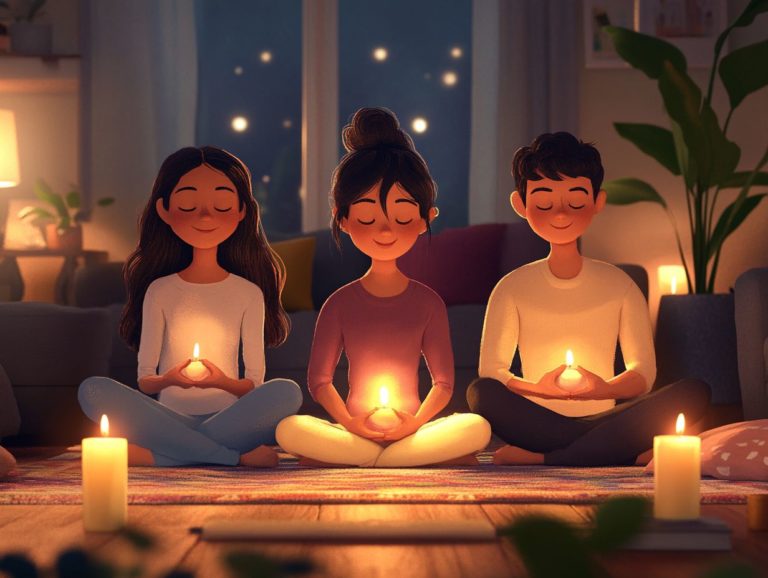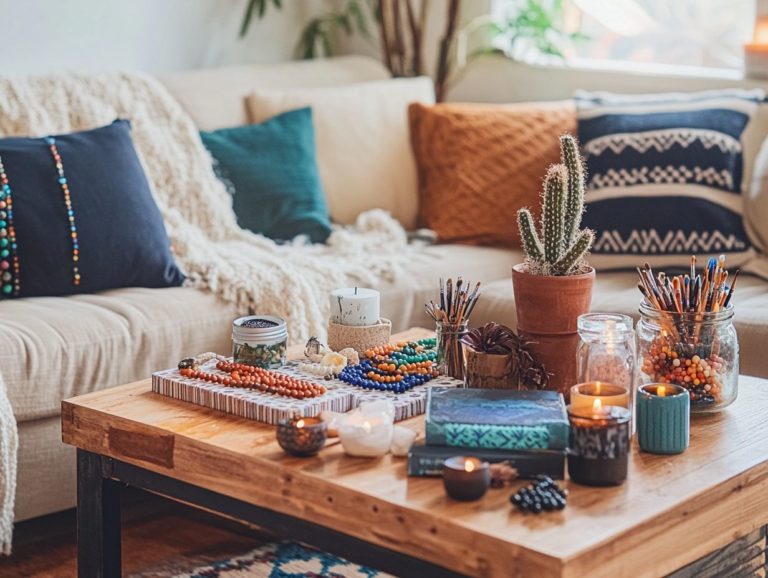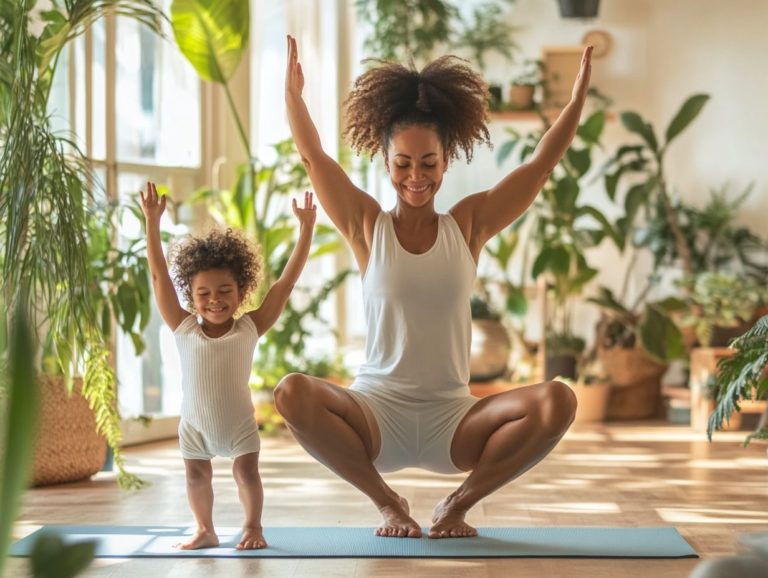Creating Mindful Spaces in Your Home
In today s fast-paced world, discovering moments of peace and clarity can often seem like an uphill battle. One effective solution lies in creating mindful spaces within your home designated areas that actively promote relaxation, focus, and mindfulness practices.
This article delves into the concept of mindful spaces, exploring their numerous benefits for mental health and well-being, and providing you with simple strategies to cultivate them in your living environment.
By incorporating natural elements and establishing a calming ambiance, you can transform your home into a calming refuge and sanctuary of serenity.
Contents
- Key Takeaways:
- What Are Mindful Spaces?
- Why Should You Create Mindful Spaces in Your Home?
- How to Create Mindful Spaces in Your Home?
- What Activities Can You Do in Your Mindful Space?
- 1. Meditation and Breathing Exercises
- 2. Yoga or Stretching
- 3. Reading or Journaling
- 4. Creative Activities like Painting or Coloring
- How Can You Maintain Your Mindful Space?
- Frequently Asked Questions
- What is the importance of creating mindful spaces in your home?
- How do I begin creating mindful spaces in my home?
- Can I create mindful spaces in small living areas?
- What are some examples of mindful spaces I can create in my home?
- Can mindful spaces benefit my physical health as well?
- Do I have to designate a specific room for a mindful space?
Key Takeaways:
- Create mindful spaces in your home to significantly reduce stress and anxiety!
- To create a mindful space, choose a quiet area, declutter and simplify, incorporate nature and soothing elements, and add comfortable seating and lighting improvements.
- Engage in activities like meditation, yoga, reading, and creative pursuits in your mindful space. Maintain it by regularly decluttering the space, setting boundaries, and incorporating mindful habits into your daily routine.
What Are Mindful Spaces?
Mindful spaces are carefully crafted environments that prioritize relaxation, well-being, and emotional intention, transforming them into sanctuaries for a stress-free existence. These spaces use design elements that embrace natural light, soothing colors, and high-quality materials, creating a serene refuge perfect for mindfulness practices like meditation and intentional breathing.
By nurturing an atmosphere of emotional awareness, mindful spaces invite you to appreciate your surroundings through a personal approach while fostering a profound sense of inner peace.
Why Should You Create Mindful Spaces in Your Home?
Creating mindful spaces in your home is essential for enhancing your mental clarity. This intentional design reduces stress while fostering a nurturing environment that supports your overall well-being.
These carefully considered choices invite peaceful moments amid the chaos of daily life and facilitate mindfulness practices that enhance your emotional awareness and spiritual healing.
By incorporating organized spaces and thoughtfully selected decorative items, you can transform areas into healing sanctuaries that radiate cozy vibes and a soothing ambiance.
1. Reduces Stress and Anxiety
Mindful spaces enhance emotional ease. They greatly reduce your stress and anxiety by crafting a calming atmosphere that nurtures relaxation and emotional intention using a sensory approach.
By integrating elements such as soothing scents and comfortable seating, you create an environment that invites you to unwind and engage in practices that foster emotional ease.
The thoughtful design elements of these spaces have the power to transform an ordinary room into a personal sanctuary. When you use warm, dimmable lighting and incorporate textures like soft fabrics and natural fibers, you enhance the overall sensory experience, making the space even more inviting.
Adding items such as Himalayan salt lamps not only improves air quality but also casts a gentle glow, cultivating a cozy atmosphere that invites serenity. Aromatherapy, which involves using plant extracts for healing, can elevate your mood, allowing your mind to drift into a state of calm.
These carefully curated elements work together harmoniously, establishing a retreat where stress and anxiety fade away, making it easier for you to center yourself and discover peace.
2. Improves Mental Clarity
Improving your mental clarity is one of the standout benefits of creating mindful spaces through intentional design. When your environment is organized and free from clutter, it allows you to think more clearly and sparks your creativity.
By intentionally decluttering your surroundings and incorporating focal points, you can significantly enhance your ability to concentrate and engage in meaningful tasks. Embracing stress-free living through organization reduces feelings of overwhelm and anxiety, contributing to emotional ease.
Adding decorative items not only elevates the aesthetic value of your space but also promotes a sense of calmness and harmony.
Utilizing a multi-purpose room strategically contributes to a more conducive environment, offering the flexibility to engage in various activities while keeping everything organized, including creative sourcing for home decor. Designate specific areas for particular functions! This small change can boost your productivity and make your work feel effortless.
3. Encourages Mindfulness Practice
Mindful spaces provide you with a sanctuary for mindfulness practices, offering a dedicated environment where you can immerse yourself in meditation, yoga, and relaxation techniques. These tranquil areas invite peaceful moments, allowing you to center your thoughts and fully engage in the present.
Beyond the physical design, the selection of soothing colors in your mindful space is essential for creating the right atmosphere. Soft blues and greens evoke a sense of calm, while warm lightbulbs cast a cozy glow that embraces you in serenity.
By establishing a designated yoga space adorned with these elements, you create an environment that helps you maintain a stress-free mindset, minimizing distractions and making you feel safe, thus encouraging mindfulness practices. Through careful curation of your surroundings, you can elevate your mindfulness practices and deepen your commitment to self-care.
How to Create Mindful Spaces in Your Home?
Creating mindful spaces in your home requires a thoughtful approach to interior design that places a premium on relaxation and serves as a calming refuge from the stressors of daily life. Integrate interior elements that contribute to a serene decor.
By thoughtfully integrating organized spaces with intentional design elements, you can cultivate an environment that fosters well-being and serenity.
1. Choose a Quiet and Calm Area
Choosing a quiet and tranquil area in your home is the essential first step to creating a mindful space that acts as your personal sanctuary for mindfulness practices. This designated spot should be free from distractions, allowing you to fully engage in activities that promote relaxation and mindfulness.
Whether you opt for a dedicated meditation room or a cozy reading nook, having a serene corner can profoundly enhance your stress-free living experience. The true magic of such a space lies in its ability to foster a soothing ambiance, where soft lighting, comfortable furnishings, and perhaps the gentle sounds of nature elevate your spirit.
By integrating elements like lush plants or calming scents, you can further enrich the environment, transforming it into a refuge from the hustle and bustle of daily life. Prioritize this tranquil corner to cultivate a sanctuary that nurtures your well-being and encourages a routine of inner peace.
2. Declutter and Simplify
Decluttering your space is vital for reducing stress and achieving emotional calm. A minimalist lifestyle starts with a clean and organized environment.
This process does more than just clear physical clutter; it also cultivates emotional awareness, enabling you to confront attachments to items that no longer serve your well-being. To effectively tackle clutter, consider sorting your belongings into three distinct categories:
- Keep
- Donate
- Discard
Choosing quality materials for the items you decide to keep, like handmade rugs and high-end rugs, represents a meaningful shift toward a minimalist lifestyle, highlighting intentionality and sustainability. As you embrace this approach, you may find improvements in your overall well-being, experiencing enhanced focus and a renewed sense of control over your surroundings.
Start creating your mindful space today, and experience the transformation in your life!
3. Incorporate Nature and Natural Elements
Incorporating nature and natural elements into your mindful space elevates the environment by aligning with principles of biophilia, creating a calming sanctuary that encourages relaxation and a sensory approach to design.
Indoor plants, natural fibers, and earthy textures offer sensory experiences that enhance emotional awareness.
The addition of lush greenery not only purifies the air but also introduces a vibrant aesthetic that complements vintage decor, like vintage film posters and vintage hi-fi gear, inviting warmth and character into your living areas.
By choosing soothing colors and high-quality materials, you achieve a seamless blend of comfort and style.
Strategically placing natural light amplifies these effects, casting soft shadows that enrich the ambiance and support your mental well-being, adding to the home decor.
These thoughtful design choices foster a harmonious interplay of elements that nurture both your mind and spirit, creating a space that truly resonates with tranquility.
4. Use Soothing Colors and Scents
Transform your mindful space by using soothing colors and enchanting scents. Using soothing colors and scents is crucial for creating a calming ambiance that promotes relaxation and comfort in your mindful space, enhancing sensory experiences.
Opt for shades of blue, green, and soft neutrals to cultivate a serene environment, while aromatherapy enhances your sensory experience.
Incorporate various textures and natural fibers to enhance this tranquil setting. Soft fabrics, like plush cushions and warm throws, are soft and inviting, while wooden elements introduce an organic feel that grounds the space beautifully.
By blending these natural textures with a thoughtfully chosen color palette think pastel hues and earthy tones you can cultivate a cozy space that helps you feel good. Infusing the air with fragrances like lavender, chamomile, or sandalwood not only uplifts your mood but also instills a sense of comfort and stability, making it simpler for you to unwind and connect with yourself. Adding indoor plants can further enhance this environment appreciation.
5. Add Comfortable Seating, Soft Lighting, and Vintage Decor
Adding comfortable seating and soft lighting is essential for creating those cozy vibes and a stress-free living environment within your mindful space. When you thoughtfully choose your furniture and opt for warm lightbulbs, you can craft an inviting atmosphere filled with soothing colors that encourages relaxation and mindfulness.
Consider adding vintage decor to enhance the aesthetic. By carefully selecting high-end rugs and decorative items, such as vintage hi-fi gear or vintage film posters, you can significantly enhance the aesthetic and overall comfort of your area, fostering a true sense of belonging.
It’s remarkable how the right lighting can elevate emotional awareness, transforming an ordinary room into a sanctuary for self-reflection and connection.
Balancing various elements from textures to hues can evoke feelings of tranquility, making it much easier for you to unwind and truly engage with your surroundings.
By prioritizing these aspects, you not only enhance the visual charm but also cultivate an environment where creativity and peace can thrive in perfect harmony. Consider incorporating biophilia principles to further connect with nature.
What Activities Can You Do in Your Mindful Space?
A mindful space in your home can serve as a sanctuary for a range of activities that enhance relaxation and cultivate mindfulness. Whether you engage in meditation, yoga, or even creative pursuits like painting, coloring, or journaling, this dedicated area nurtures emotional awareness and supports your overall wellbeing.
Utilizing quality materials and vintage decor can elevate your experience. Embracing the practices within this serene environment can truly transform your daily routine and elevate your sense of peace.
1. Meditation and Breathing Exercises
Meditation and breathing exercises are fundamental practices for cultivating mindfulness in your chosen mindful space. These soothing activities create a tranquil moment, allowing you to connect with your inner self and enhance your emotional awareness.
By integrating breathing with awareness into your daily routine, you can experience significant stress reduction, improving your overall emotional health. Designing an environment with quality elements think comfortable seating and calming scents can elevate the meditative atmosphere.
Simple techniques, such as concentrating on your breath or visualizing serene landscapes, can further amplify the benefits of these practices. Dedicating a specific time each day for meditation is advantageous as it enables your mind to settle and engage more deeply.
Embrace these approaches for greater clarity, heightened awareness, and a profound sense of tranquility in your everyday life. Start your mindfulness journey today create your serene space!
2. Yoga or Stretching
Engaging in yoga or stretching exercises within your mindful space can elevate your relaxation techniques and promote emotional ease. These practices enhance not only your physical well-being but also nurture your mental state, offering a holistic method that considers the whole person.
Transform your space into a multi-purpose haven! Exploring various yoga styles like Hatha for gentle movements or Yin for deeper stretches can be tailored to suit your unique preferences and needs. Incorporating calming scents such as lavender through essential oils can transform the atmosphere into a tranquil haven.
Surround yourself with calming colors like soft blues and greens, which can work wonders in reducing stress and instilling serenity. Prioritize a cozy environment with comfortable mats and bolster pillows to encourage relaxation, crafting an ideal setting for self-discovery.
3. Reading or Journaling
Reading or journaling in your mindful space can significantly enhance your mindfulness practice, providing you with a tranquil moment to reflect and unwind. This activity encourages introspection and emotional awareness, contributing to your overall well-being.
By engaging in these practices, you can escape daily stresses, promoting a serene environment that nurtures creativity and clarity. Cozying up with genres like poetry or self-help books can ignite creativity while journaling clarifies your thoughts and emotions.
Explore techniques like bullet journaling and gratitude journaling to enhance emotional awareness. These methods not only help organize ideas but also pave the way for a more stress-free life.
When you couple these rituals with a calming ambiance soft lighting and soothing scents you can transform an ordinary moment into a sanctuary for your mind and spirit. Start journaling today to enhance your mindfulness journey!
4. Creative Activities like Painting or Coloring
Engaging in creative activities such as painting or coloring can transform your mindful space into a therapeutic haven, enhancing relaxation techniques while nurturing emotional awareness. These activities offer a wonderful outlet for self-expression and foster a profound sense of calm.
Incorporate vintage decor and healing spaces principles to elevate your experience. By adding elements like textured papers and vibrant paints, you craft an inviting atmosphere that feels cozy.
Moments spent creating, whether through knitting or journaling, serve as reminders of the present, encouraging mindfulness as you immerse yourself in the process. The sensation of smooth paint gliding across canvas or the comforting touch of soft yarn deepens your connection to creativity, promoting relaxation.
Consider sourcing your materials from quality brands for a more personal approach. Start your creative adventure today let your imagination flow!
How Can You Maintain Your Mindful Space?
Maintaining your mindful space is essential for ensuring it continues to function as a calming refuge. Regular cleaning and organization not only help preserve its tranquil ambiance. They also enhance its effectiveness as a sanctuary. Utilize clutter removal strategies to maintain organized spaces.
Adopt mindful habits and routines to keep the environment inviting and conducive to relaxation. This allows you to fully embrace the serenity it offers. Consider integrating UCLA’s Center on Everyday Lives and Families principles for enhanced emotional intention, which means the feelings you want to bring into your space.
1. Regularly Clean and Declutter
Regularly cleaning and decluttering your mindful space is crucial for maintaining organized environments. These promote stress reduction and emotional awareness. A tidy space helps you think clearly. It supports your mindfulness practices.
Consider adding Himalayan salt lamps. They are known for their decluttering and stress reduction properties. Adopting a consistent approach to tidiness significantly contributes to your overall sense of well-being.
By choosing quality materials like storage solutions crafted from sustainable resources you not only reduce clutter but also elevate the aesthetic appeal of your surroundings. This thoughtful organization creates a calming ambiance, making it easier for you to cultivate a peaceful environment where you can unwind and reflect. Incorporate handmade rugs to further enhance the space.
When you prioritize the organization of your belongings, navigating daily life becomes much simpler. Ultimately, this leads to improved focus and tranquility. Embracing effective cleaning and decluttering strategies transforms your living spaces into true sanctuaries of calm. Consider products from Natures Artifacts for an added touch of serenity.
2. Set Boundaries and Respect Your Space
Setting boundaries and honoring your mindful space is essential for sustaining its purpose and enhancing your emotional awareness. By clearly defining how this space is to be used, you can ensure it remains a serene sanctuary for relaxation and mindfulness practices. You might use vintage film posters as focal points to signify its importance.
Creating a soothing refuge requires open communication about your needs and expectations. Establishing guidelines that both you and those around you can adhere to is crucial in minimizing interruptions during your mindfulness exercises. Use special signs or closed doors to signify your need for privacy.
Designate specific times for your calming practices when social interactions are best avoided. Visual cues, such as a closed door or a special sign, can effectively communicate your desire for uninterrupted time. This approach aligns with Joy Rains and Laura Sage s recommendations for creating a dedicated mindfulness space.
Ultimately, your journey toward stress-free living relies on your ability to advocate for your well-being. This allows your mindfulness space to thrive without unnecessary distractions. Embrace the wisdom of experts like Kim Matheson Shedrick and Susan Petrie for tailored advice on maintaining a peaceful environment.
3. Incorporate Mindful Habits into Your Daily Routine
Start incorporating mindful habits today for immediate benefits! This can significantly enhance the effectiveness of your mindful space, reinforcing relaxation techniques and promoting emotional ease. Regular practice of mindfulness offers lasting benefits for your overall well-being.
Intentionally set aside time for meditation practices. This allows you to cultivate a deeper connection with your thoughts and emotions. Using good materials, such as comfortable cushions or textured blankets, creates an inviting atmosphere that encourages mindfulness.
Enhance your surroundings with soft lighting or soothing scents, like those from Brooklyn Candle. This can elevate the experience, making it easier for you to unwind from daily stresses.
You can incorporate short moments of mindfulness throughout your day like taking a few deep breaths during work breaks. This solidifies these habits, allowing you to embrace a more centered and balanced lifestyle with emotional ease and stress reduction.
Frequently Asked Questions
Creating mindful spaces in your home can significantly enhance your mental and emotional well-being. Imagine creating a serene corner just for you! What would it look like?
What is the importance of creating mindful spaces in your home?
Creating mindful spaces in your home allows you to cultivate a sense of calm and peace, promoting stress-free living and relaxation techniques.
How do I begin creating mindful spaces in my home?
Start by removing clutter and organizing your space. This will create a sense of order and promote a clear mind. Incorporate calming elements like indoor plants, candles from Brooklyn Candle, and natural light for a cozy atmosphere.
Can I create mindful spaces in small living areas?
Absolutely! Mindful spaces can be created in any size living area. It’s all about maximizing the space you have and incorporating elements that promote relaxation and mindfulness activities.
What are some examples of mindful spaces I can create in my home?
A meditation corner, a reading nook, a designated yoga area, or a simple sitting area with comfortable pillows and blankets from Belka Pillow can all be considered mindful spaces. Integrate soothing colors and handmade rugs to enhance the ambiance.
Can mindful spaces benefit my physical health as well?
Yes, mindful spaces can help reduce stress and anxiety, positively impacting your physical health and well-being. They can also serve as a space for physical activities such as yoga or stretching.
Do I have to designate a specific room for a mindful space?
No, you can create mindful spaces in any part of your home. It can be a corner in your bedroom, a small area in your living room, a multi-purpose room, or even a balcony or outdoor space. Consider integrating vintage decor like vintage film posters for added cozy vibes.
Don t wait! Start transforming a corner of your home into a mindful space today, and share your experiences or explore more tips!




